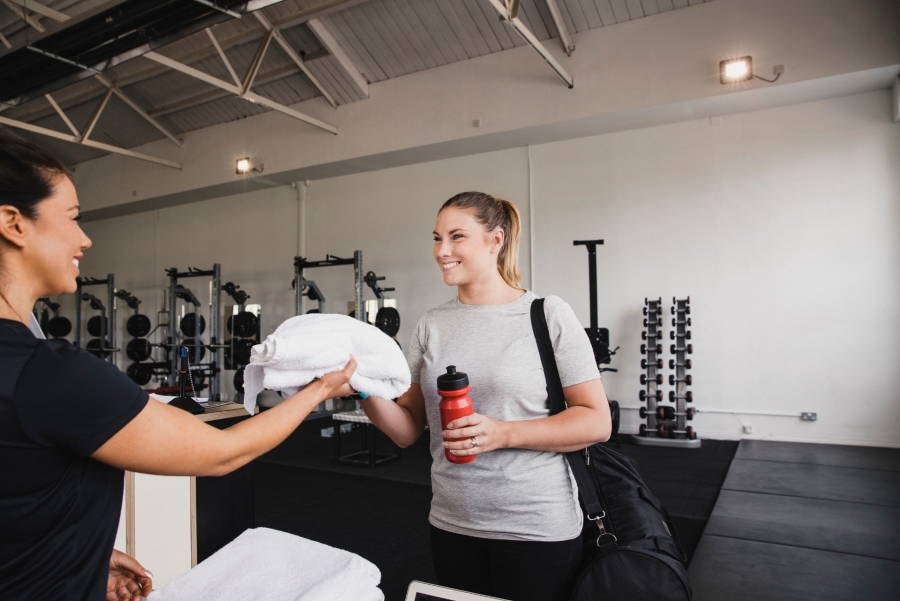1. Build a High-Performance Website
Your website is the digital front door of your fitness chain. A user-friendly, fast and informative website is critical for attracting potential members and retaining existing ones.
What your website should include:
- Easy navigation and mobile responsiveness
- Detailed information about each location, operating hours, services and facilities
- An intuitive, user-friendly member portal for managing memberships, bookings and payments, making it easy for customers to stay engaged
- A seamless integration with payment gateways, booking and membership management systems
- Accessibility features to cater to all users, ensuring inclusivity
- Engaging visuals, including photos and videos of your facilities, classes and amenities
Pro Tip: Use geo-targeted landing pages for each location to optimize for local searches and provide relevant content to potential members. Additionally, implement A/B testing to continuously refine your website’s performance and design based on user behavior.
2. Master Local SEO for Each Location
Enterprise gym chains thrive on local engagement and local SEO is your gateway to dominating search results for potential members in target markets. Each of your gym locations must be optimized to ensure visibility, accessibility and relevance in local searches. This means tailoring your digital presence to meet the unique needs of each community while aligning with your overall brand strategy.
How to master local SEO?
- Set Up a Google Business Profile for Each Location
Ensure each of your gym location has its own Google Business Profile (GBP) with up-to-date information. Include accurate details such as the address, phone number, website link, business hours, photos of the facility and even popular classes or amenities. Respond actively to member inquiries and comments posted on your GBP, as engagement signals enhance your profile’s visibility.
- Optimize Location Pages on Your Website
Build dedicated landing pages for each gym location, including rich content such as:
- Photos and virtual tours of the facility
- A description of services, amenities and unique features
- Staff introductions to add a human touch.
- Upcoming events or promotions specific to the location
- Integrate schema markup (local business schema) to help search engines understand your content better and rank it higher in local search results.
- Ensure Consistent NAP Across Listings
Consistency is crucial for building trust with search engines. Use identical NAP (name, address, phone number) details across all platforms. Double-check details for accuracy and consistency whenever a new location is added or existing ones are updated.
- Target Location-Specific Keywords
Conduct keyword research to identify the most relevant location-based search terms, such as “gyms near [city],” “24-hour gym in [neighborhood],” or “best fitness center in [region].” Use these keywords strategically in your website copy, blog content and PPC campaigns. For blog content, consider writing hyper-local guides like “Top 5 Gyms in [City] Open 24/7” or “The Best HIIT Workouts Near [Neighborhood].”
- Leverage Member Reviews for Local Visibility
High ratings and glowing reviews are critical drivers for local search rankings. Create a system that encourages satisfied members to leave reviews for individual locations on platforms like Google and Facebook. For example, send post-visit emails prompting feedback or set up QR codes in your gym directing members to review platforms. Respond promptly and professionally to both positive and negative reviews.
- Geo-Targeted Content Marketing
Develop localized blog posts and promotional materials tailored to each location’s community. Share content such as upcoming fitness events in the city, partnerships with local businesses, or success stories of members from that area. Not only does this approach boost local search rankings, but it also positions your gym as a key part of the community.
- Enhance Location Listings with Visual Content
Visual content boosts engagement and click-through rates on your listings. Upload high-quality photos of the exterior (to help users recognize the location), interiors, gym equipment and even classes in action. Video content, such as a quick gym tour or member testimonials, can also significantly impact how potential members perceive your gym.
- Engage with Local Directories and Community Sites
Many people still rely on local directories to find businesses. Get listed in local directories, chamber of commerce websites, or regional fitness blogs. Partner with these platforms to write guest posts or get featured, as these backlinks contribute to your SEO efforts.
- Utilize Hyper-local Social Media Ads
Run hyper-targeted ad campaigns on social media platforms like Facebook and Instagram to reach people within a specific radius of your gym locations. For example, highlight unique promotions like “Join [Location Name] this week and get your first month free!” Tailor these ads to the demographics and preferences of each local community.
- Track and Analyze Your Local SEO Performance
Use tools like Google Analytics, Google Search Console and SEMrush to monitor the performance of your local SEO strategy. Measure KPIs such as:
- Search impressions and clicks for location-specific pages
- Rankings for local keywords
- Reviews generated per location
Continuously refine your strategy based on these insights to stay ahead of local competitors.
3. Track and Optimize Your Fitness Marketing Campaigns
Client acquisition increasingly happens online, making it essential for fitness chains to track which marketing channels are driving the most traffic, engagement and leads. Without proper tracking, you risk inefficiently allocating your marketing budget. Here's how to ensure your campaigns deliver measurable results.
Implement Goal Tracking in Google Analytics
Setting up goal tracking in Google Analytics allows you to measure the success of your marketing efforts. Goals can range from website visits to membership sign-ups or class bookings. If you’re unsure how to set up goals, resources are available to guide you, or consider involving a developer to streamline the process.
Utilize UTM Tags for Campaign Insights
To gain deeper insights into campaign performance, attach UTM tags to every link you share through your marketing channels – whether it’s social media posts, email newsletters, or online ads. By defining the campaign name, source (e.g., “Facebook”), and medium (e.g., “CPC”), you can track exactly where your traffic is coming from.
These tagged links, combined with goal tracking, enable you to see how each campaign contributes to conversions. Over time, this will help you identify which channels and strategies are most effective for driving engagement and sign-ups.
Go Beyond Basic Tracking with Integrated Systems
For gym chains managing multiple locations, integrating your analytics tools with a centralized system can provide even more clarity. While Google Analytics offers valuable metrics, integrating with an advanced club management platform, like PerfectGym, ensures a seamless view of the entire member lifecycle – from their first click to their ongoing membership journey.
Harness Data for Smarter Member Acquisition
Once you’ve established clear tracking and analytics processes, focus on using the data to acquire high-value members. Understanding your current members is key to attracting the right new ones. For example:
- Identify patterns among your most loyal or long-tenured members.
- Use those insights to create lookalike audiences for targeted campaigns on platforms like Facebook Ads or Google Display Network.
To take this further, integrate business intelligence tools with your club management system. By doing so, you can centralize key data points such as attendance trends, member behavior, and payment history. These insights help you refine your audience targeting and develop highly personalized marketing campaigns. For example, predictive analytics can highlight members at risk of churn or pinpoint demographic patterns that signal strong retention.
Inform Future Campaigns with Performance Insights
Tracking campaigns isn’t just about the immediate results – it’s about learning what works and refining your approach over time. Whether you're planning a new seasonal promotion or a long-term digital marketing initiative, having a clear understanding of your past performance can guide smarter decisions in the future.
By leveraging advanced tools and a data-driven mindset, your marketing campaigns can become more precise, impactful and tailored to your target audience’s needs – while also paving the way for stronger member engagement and retention.
4. Invest in Video Marketing
Video content is highly engaging and effective for fitness chains. It offers a dynamic way to connect with prospective and current members while showcasing the unique value of your gyms. Popular video formats include:
- Member testimonials: Real stories from your members can build trust and inspire prospects to join.
- Behind-the-scenes looks at fitness classes: Highlight the energy and community within your gym.
- Instagram reels or TikToks featuring trending workouts: Leverage social media trends to connect with a broader audience.
- Virtual tours: Allow prospective members to explore your facilities from the comfort of their homes.
View this post on Instagram
A post shared by Planet Fitness (@planetfitness)
Enterprise gyms can utilize YouTube ads to target specific markets and demographics. By creating region-specific campaigns, you can cater to the unique preferences and needs of members in different locations.
For social platforms, ensure each location has its own profile to foster local engagement. Use these profiles to share location-specific content, such as community events, instructor highlights, or unique class offerings. Additionally, focus on short, engaging videos for platforms like Instagram Stories or TikTok, which cater to users with shorter attention spans.
To maximize the impact of your video marketing efforts, consider investing in professional videography for high-quality production. Pair these videos with compelling CTAs, such as "Join now" or "Book your free trial," to encourage immediate action. Finally, track performance metrics like views, shares, and conversions to continually refine your video marketing strategy.
5. Start a Referral Program and Let Existing Members do the Work for You
Your members can be your best marketers. By providing outstanding services and facilities and offering enticing incentives, you can create a gym referral program that encourages members to invite their family and friends to join. Not only does this leverage word-of-mouth marketing, but it also builds a sense of community within your gym.
When a member successfully refers someone who joins as a new member, rewarding both the referrer and the new member can significantly boost participation. This mutual reward system motivates continued referrals and fosters loyalty – all at minimal cost.
How to Implement a Referral Program
There are several ways to launch and manage a successful referral program:
- Integrate it into your club’s mobile app: A seamless digital experience makes referrals easier for members and staff alike. Members can share referral links or codes directly from the app, while you can track and manage rewards in real time.
- Email campaigns: Encourage referrals by sharing program details and incentives directly with members via email.
The key to a successful referral program is making sure members know about it. To maximize awareness:
- Share announcements and updates on social media.
- Send promotional emails outlining the program and its benefits.
- Use in-club signage, such as posters or banners, to catch members’ attention.
- Highlight the program on your gym’s website and member portal.
For enterprise gyms, having a module for referrals in your mobile app offers a more streamlined and user-friendly approach. For example, members can instantly share their unique referral code and leads can input this code when signing up or redeeming a guest pass.
6. Gym Promotions to Attract New Members
“New year, new me.” January brings a surge in motivation, making it the perfect time for gyms to attract new members with time-limited discounts. However, gym promotions can be successful year-round, provided they leverage the power of urgency and scarcity. Limited-time offers are more compelling than ongoing deals, which can devalue your pricing and diminish excitement.
To make your promotion stand out and reach a wider audience, consider the following approaches:
- Paid digital campaigns: Use Facebook Ads or Google Ads to target potential members by location and interests, linking them to a clear call-to-action landing page.
- Print and billboard advertising: While harder to track, these are valuable in competitive markets for raising brand visibility.
For print or billboard ads, train your staff to ask new leads how they heard about your promotion. For digital campaigns, use UTM tags and analytics tools to track performance.
Tailored Approaches by Market
In competitive urban areas, consider traditional methods like billboards or event sponsorship to complement your digital presence. In less crowded markets, focus heavily on geo-targeted digital ads to dominate online spaces.
By crafting time-sensitive, well-promoted campaigns and monitoring their success, you can effectively attract new members while maximizing your marketing ROI.
7. Affiliate Marketing for Fitness Facilities
If you're searching for innovative ways to get more gym members, affiliate marketing could be the perfect solution. This strategy involves partnering with external individuals or businesses to refer potential members to your gym. By leveraging the trust and influence these affiliates have with their networks, you can attract new members efficiently and cost-effectively.
Even in less populated areas, plenty of businesses can become valuable referral partners, including:
- Doctors: Recommend memberships as part of wellness or rehabilitation plans.
- Physical therapists: Suggest memberships to help clients maintain progress post-rehabilitation.
- Supplement providers and fitness stores: Promote your gym as the go-to place for their health-conscious customers.
- Personal trainers: Offer them commission-free training spaces for their clients with active memberships.
You can motivate your affiliates in several ways:
- Offer discounted memberships for their business or employees.
- Pay a referral bonus, such as 10% of a new member’s contract value.
- Provide perks like commission-free client training spaces to personal trainers.
Affiliate marketing is more than just a member acquisition tool – it’s a way to build community partnerships that enhance your gym's reputation. For example, personal trainers who bring their clients to your gym foster a strong connection between the client and your facility, boosting retention rates.
By forming strategic partnerships with trusted professionals and offering meaningful incentives, affiliate marketing can serve as a powerful and scalable way to grow your membership base.
Concluding Thoughts
Optimizing your fitness chain’s marketing strategy across different markets requires a combination of localized efforts, data-driven insights, and innovative campaigns. By implementing these strategies, mid-size and enterprise gym chains can effectively attract new members, retain existing ones, and scale their operations for long-term success.









